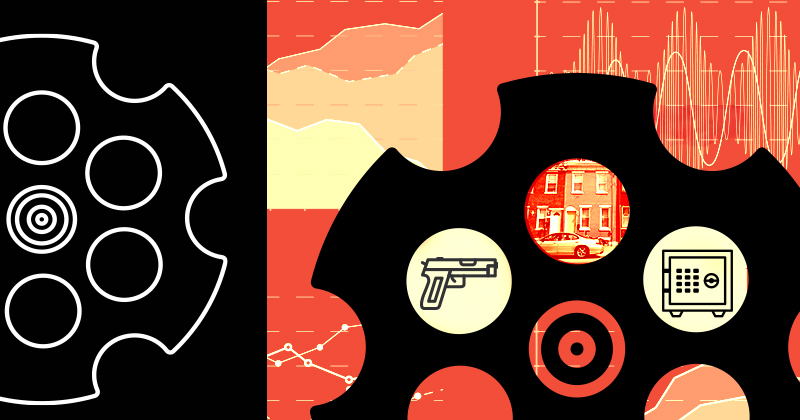


Firearm storage realities
Photo illustration by Jeffrey C. Chase | Photo by Ashley Barnas Larrimore June 20, 2025
UD research finds social factors drive decisions about firearm storage
Tarang Parekh was getting ready for work at his apartment in Houston, Texas, in 2022, when he heard gunfire. He’d never heard the sound before, except on TV, but instantly recognized it. He ran downstairs and saw a gruesome scene. It wasn’t something he ever expected to see where he lived.
Parekh is not alone. In 2022, more than 48,000 lives were claimed by gun violence in the U.S.
That experience inspired Parekh, now an assistant professor of epidemiology at the University of Delaware College of Health Sciences, to investigate potential links between social drivers or determinants of health (SDOH), such as housing and food insecurity, financial hardship and transportation barriers, with firearm ownership and storage practices.
“Gun violence isn’t just about individual behavior or mental health,” Parekh said. “We need to understand the broader social conditions that drive gun ownership and influence how firearms are stored.”

Parekh teamed up with fellow epidemiologist assistant professor Jee Won Park and master of public health in epidemiology students Annaliese Pena and Meghana Bhaskar to conduct a cross-sectional analysis using self-reported data from the 2022 Behavioral Risk Factor Surveillance System. They examined responses from nearly 63,000 adults in five states — California, Minnesota, Nevada, New Mexico and Ohio — where questions on both firearm storage and social factors were included in the survey.
Their analysis found that firearm ownership was more prevalent among non-Hispanic white households with higher incomes and higher education. Unsafe gun storage was more common among non-Hispanic Black and lower-income households, where SDOH and high-risk behaviors, including substance use disorders and depression, were identified. Their findings were recently published in JAMA Network Open.
Among the social factors surveyed, financial hardship and housing and food insecurity were significantly associated with unsafe firearm storage practices.
“I expected to see financial hardship and living in an unsafe environment impact gun ownership and storage behaviors, but I was not expecting to see social drivers like food and housing insecurity and transportation barriers to have such a significant impact on firearm storage behaviors,” Parekh said.
Policy and prevention
Some states, like California and Minnesota, have Child-Access Prevention (CAP) laws that make it illegal to leave guns unsecured in households with children. In these states, people were more likely to store guns safely.
According to Everytown Research & Policy, Delaware is one of 26 states with a CAP law; however, Parekh believes these laws could be stronger. California, for example, is the only state that mandates locking devices with firearm purchases.
Gun buyback programs, which Delaware has previously held, could also be beneficial.
“We must provide more incentives or financial benefits,” said Parekh, pointing to Canada and New Zealand, where buyback programs have been more successful.
Identifying the root causes
Parekh’s findings call for a shift in focus on individual mental health to systemic socioeconomic factors as keys to understanding the behaviors that drive gun ownership.
“Whenever we hear about mass shootings, the ‘dangerous people’ phenomenon arises,” explained Parekh. “We must shift our focus and determine why the person owns a gun and whether housing insecurity or living in an unsafe environment influences their behavior, instead of jumping to the conclusion that the person has mental health issues.”
The COVID-19 pandemic also fueled gun ownership.
“After COVID, there was a massive jump in firearm ownership, especially among racial minority populations, where owning a gun made them feel safer,” Parekh said.
The most effective solutions, he believes, lie in community-based education and support.
“We constantly talk about changing laws, but laws alone won’t solve the problem,” Parekh said. “We need to invest in our communities to improve the social and environmental factors that contribute to firearm ownership.”
Next, Parekh plans to investigate differences in state gun laws and their intersection with SDOH.
“Gun ownership and safe storage aren’t just about Second Amendment rights,” he said. “It’s about understanding why people feel the need to own a firearm in the first place — and how making our communities safer could change that decision.”
Contact Us
Have a UDaily story idea?
Contact us at ocm@udel.edu
Members of the press
Contact us at mediarelations@udel.edu or visit the Media Relations website

